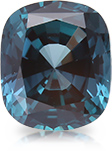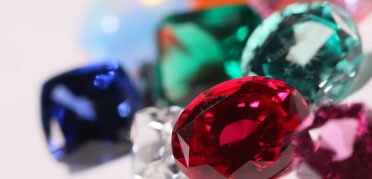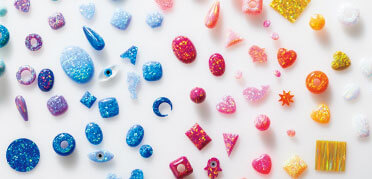Jewelry Glossary
-
A
-
Ablation
Tiny scratches on faceted ridges.
-
Acetone Inspection
Acetone inspection is an examination to confirm the presence and the degree of the gemstone's oil impregnation.
-
Actinolite
Actinolite is a kind of amphibole, and the name which means "emission light," comes from the form of a unique crystal. Nephrite jade is a family of actinolite because it is a collection of tremolite, a group of amphiboles. Transparent actinolite stone would be a facet cut, and the opaque stone would be cut into a cabochon cut.
[Moh's hardness: 5] [Mineral species: Actinolite] -
Adjuster
As the name suggests, an "adjuster" is the part of a necklace used to adjust its length.
-
Agate
Agate is brownish chalcedony with a unique stripe pattern.
It is produced in chunks of translucent small crystals. It can be tumbled and polished in its natural state to bring out various patterns or it is treated (dyed) to be material for jewelry.
[Moh's hardness: 6] [Mineral species: Chalcedony] -
Akoya Pearl
Because akoya shellfish is small compared to other mother shells, the size of cultured pearls is also small. In Japan, the water temperature is colder than the South Sea, so the akoya shells in Japan have unique, beautiful, strong gloss. Elements to determine the value of pearls are the type of mother shell, size, shape, the thickness of pearl layer, scratch, color and the gloss on the surface. The thickness of the pearl layer needs to be more than 0.7 mm, but there are also thin layer ones to finish aquaculture in a short period. High-quality cultured pearls have fewer scratches and strong gloss. The size is about 2 to 10 mm, and the general size is about 6 to 7 mm.
[Moh's hardness: 2.5-3] [Organic matter: Cultured pearl]" -
Alexandrite
The name alexandrite comes from Emperor Alexander II, who was the Romanov Prince in the Ural region of Russia in 1830.
Alexandrite reveals different colors under various lighting conditions because of its chromium content. In the sunlight, it’s a deep blue green. By candlelight, it looks purplish-red. Lower quality stones will demonstrate lesser color changes, sufficient transparency is another indicator of quality.
Crescent Vert alexandrite possesses the same vivid color-changing properties as high-grade natural stones from Russia’s Ural Mountains.
Please click
here
to learn more about Kyocera's Crescent Vert alexandrite.

Alexandrite

Alexandrite reveals different colors under various lighting conditions. In the sun, it’s a deep blue-green. By candlelight, it looks purplish-red. Collectors covet this stone and its mysterious color signature, caused by trace amounts of chrome within the gem. Crescent Vert alexandrite possesses the same vivid color-changing properties as high-grade natural stones from Russia’s Ural Mountains.
Available in sizes up to 10 carats.* If you need a larger stone, please contact us.View Comparison Table Item Crescent Vert Alexandrite Natural Alexandrite Chemical Composition BeAl2O4 BeAl2O4 X-ray Diffraction Same as natural stone A pattern specific to Alexandrite Spectroscopic Analysis Same as natural stone Specific absorption of Alexandrite Crystal system Orthorhombic Orthorhombic Mohs Hardness 8.5 8.5 Specific Gravity 3.71 3.71~3.72 Melting Point 1870℃ 1870℃ Transparency Transparent Transparent Refractive Index 1.743~1.752 1.747~1.757 Double Refraction 0.009 0.01 Average Dispersion 0.015 0.015 Pleochroism (Daylight)
Bright bluish green, Pale yellow, Dark purplish red
(Incandescent light)
Bluish green, Pale yellow, Reddish purple(Daylight)
Bright green, Pale yellow, Red
(Incandescent light)
Bright green, Reddish yellow, RedChelsea Color Filter Examination Red Red
[Moh's hardness: 8] [Mineral species: Chrysoberyl] -
Alexandrite Cat's Eye
Alexandrite and cat's eye are the same mineral.
To the untrained eye the two might not seem to be the same mineral because of the differences in their appearance and effects. However, alexandrite cat's eye shows both the color-change effect and the cat's eye effect at the same time.
[Moh's hardness: 8] [Mineral species: Chrysoberyl] -
Almandite Garnet
Almandite garnet is a gem in the garnet group. Its name is derived from Alabanda (now Alafsar) a city in Turkey where this mineral has been mined for a long time. It features a pinkish red color compared to pyrope.
It may also be included as an inclusion in diamond.
[Moh's hardness: 7] [Mineral species: Almandite garnet] -
Amazonite
The mineral amazonite is microcline used as ceramic raw materials and abrasives. Blue-green microcline containing leads is sold as amazonite at the market. It is named from the Amazon River image in South America but is not produced near that area. It is a vulnerable stone to shocks and sudden temperature changes because of its strong cleavage.
[Moh's hardness: 6] [Mineral species: Microcline] -
Amber
Amber is mainly polished to beads and cabochons. The barrel shape and olive shape design brings unique attractiveness to amber. The main color of amber is brownish yellow and cognac color, but recently, transparent lemon color is also popular. Amber has a unique beauty like candy, and it is good to choose any color you like because its value does not depend on colors.
[Moh's hardness: 2-2.5] [organic matter: Amber]" -
American Type Earrings
The "American type" has a post at the end of the chain, and the chain is inserted into the piercing hole along with the post, allowing the two ends of the earring to hang down. They are also called "American earrings." It is said that the name derives from the fact that Native Americans wore these earrings. These earrings do not have catches.
-
Amethyst
Purple crystals are called amethyst within the quartz family. In ancient Greece, it was an amulet to prevent drunkenness. Sought after characteristics include color depth, transparency level, color evenness and scratches visible to the naked eye. Some amethysts are irradiated to improve their appearance.
[Moh's hardness: 7] [Mineral species: Quartz] -
Andalusite
Andalusite is derived from Andalusia, Spain where the gem was produced. The gem is hard enough to be a wearable gemstone. Because of its pleochroism, change of color by light can be seen and it is similar to some alexandrite with weak color change.
[Moh's hardness: 7] [Mineral species: Andalusite] -
Andradite Garnet
Andradite is called "Topazolite" if it features a yellow coloration because of its resemblance to topaz. Green andraite are called "Demantoid," and black andraite is called "Melanite."
The level of dispersion of the andradite is stronger than diamond (0.054) at 0.057.
[Moh's hardness: 7] [Mineral species: Andradite garnet] -
Anklet
An anklet is jewelry worn around the ankle. The mainstream styles are simple chains or chains with a small charm, so sometimes anklets are called leg chains. The average length of the chain is about 22cm.
-
Annealing
Annealing is a heat treatment that lowers hardness. Through jewelry production, annealing is conducted many times. In particular, annealing needs to be done for K18, which has high vickers hardness.
-
Apatite
Apatite is a mineral resource of phosphorus such as match. It was named "Apate," which means betrayal in Greek. Apatite is transparent and shiny, and it has a wide color variation. It is often finished with a facet cut.
[Moh's hardness: 5] [Mineral species: Apatite] -
Aquamarine
The word "Aquamarine" comes from "Aqua" meaning water and "Marine" meaning sea in Latin.
It features light blue colors calling to mind clean and cool water. In the past, it was called "mermaid tears" and "treasure of the sea spirit," it was worn as a voyage amulet by sailors. Some aquamarine is already blue and brownish when it is collected, while others bring out the color by heating a pale green and brownish one.
[Moh's hardness: 7] [Mineral species: Beryl] -
Aragonite
Aragonite is a calcium carbonate mineral, same as calcite. Biological activities also generate it. Pearls and shells are also made of aragonite. After the shell loses their life, it changes to a stable calcite.
[Moh's hardness: 3.5-4] [Mineral species: Aragonite] -
Armlet
A bracelet is jewelry worn around the wrist, and an armlet is jewelry worn around the upper arm. A popular armlet style is a bangle-like horseshoe design.
-
Asterhythm
Asterhythm is also called the star effect, which is the appearance of six stars on the cabochon-cut gemstones when illuminated.
-
Automatically Programed Cutting
Automatically programed cutting is a method of processing wax prototypes for jewelry with cutting machines for wax. Computer-designed 3D design data and cutting machines are linked together, automatically creating hard wax prototypes.
-
Aventurescence
Aventurescence is a pattern of brilliant flashes caused by inclusions in minerals such as some quartz.
-
Aventurine Quartz
Aventurine quartz is named as such because the glow of small grains is similar to aventurine glass.
Many colors such as brown, reddish brown, yellow, green, blue green color are produced. Micro crystals arranged in a certain direction make the brilliance look like gold powder.
[Moh's hardness: 7] [Mineral species: Quartz] -
Axinite
It is named after its dolabriform (shaped like the head of an axe) crystals. Generally, its color is transparent brown, but also violet ones exist. Typically there are many scratches on the surface, it is mainly a collector's item. It may be confused with "Smokey quartz" because the color and shape are similar.
[Moh's hardness: 6] [Mineral species: Axinite]
-




